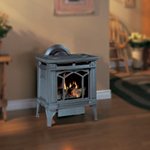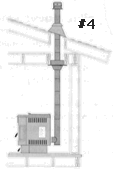Owning a home is the
American dream, but the expense of heating your home with
electricity, oil or gas can be a real nightmare. Only Lopi
convection wood stoves offer the even, penetrating heat that
comfortably warms every room in your home. Lopi stretches your
heating dollar by using a five-sided convection chamber to circulate
air around the stove and push warm air back into the room. As an
added benefit, several models offer a radiant cooking surface for
warming soup and cider or frying up eggs and bacon. These features
translate to your family being warm and cozy even during a power
outage that lasts for days.
Lopi E.P.A.-certified
stoves emit as little as 1.9 grams of particulate per hour, over 95%
less than old wood stoves! This means Lopi stoves use substantially
less wood to get the same amount of heat than from a comparably
sized older wood stove. Now you can heat your home for less money
than ever before. At the same time you can feel good about keeping
the air clean and breathable.
Lopi offers the
closest clearances to combustible surfaces of any wood stove giving
you maximum location flexibility. Distinct finishing touches such as
a selection of leg styles, a solid brass door and etched glass can
create a unique look that fits your individual sense of style.


Avalon offers
appliances that burn wood, natural gas or propane (LP) or pellets.
Wood is the
traditional fuel for supplementary heating. Avalon woodstoves and
inserts produce lots of warm, soothing heat and the large viewing
glass allows an ever-changing display of glowing coals and dancing
flames. Several of
our woodstoves have a convenient cooking surface, a benefit that
should not be overlooked when severe weather knocks out the power.
The advantages of wood are: Independence from utilities if the power
goes out; an efficient, low cost fuel; extremely low particulate
emissions that help protect winter air quality; and burning wood
actually reduces the impact on global warming because firewood is
carbon neutral.
of
our woodstoves have a convenient cooking surface, a benefit that
should not be overlooked when severe weather knocks out the power.
The advantages of wood are: Independence from utilities if the power
goes out; an efficient, low cost fuel; extremely low particulate
emissions that help protect winter air quality; and burning wood
actually reduces the impact on global warming because firewood is
carbon neutral.
Gas is a
convenient, labor-free fuel. Just set a thermostat or press a button
and your fire instantly appears.
Pellets made
of compressed wood waste are another popular fuel. Pellet fuel is
distributed in 40 pound bags and is available at most hardware
stores, feed stores, lumber yards, even large grocery stores as well
as hearth products stores. Pellet appliances are self
igniting, and they can operate from a thermostat.


The Classic Wood Stove is the
perfect combination of high technology engineering and classical
design.
All Classic Wood Stoves offer wide
view doors for an unparalleled view of the beautiful real wood fire.
Add the warmth and comfort of a real wood burning
stove to your home today.


How Do Pellet Stoves Work?
Pelle t
appliances automate as many functions as possible. The most
significant is fuel delivery. The heat setting made by the
operator controls an auger or similar feed device that delivers
regulated amounts of fuel from the hopper to the fire (Figure
2). Automatic fuel delivery from the hopper frees the operator
from frequent attention and loading, while providing clean burns
and the desired comfort level. The amount of air needed for
optimum combustion efficiency is delivered automatically or with
minor manual adjustments. In most designs, a fan delivers air to
the fire and blows exhaust by-products out of a vent pipe that
is smaller and typically less expensive than a chimney (Figure
3). In most designs, a fan delivers heat to the home by blowing
air through heat exchangers in the stove and out into the home.
Heating efficiency is greatly enhanced by removing the heat from
the appliance before it can exit the system.
t
appliances automate as many functions as possible. The most
significant is fuel delivery. The heat setting made by the
operator controls an auger or similar feed device that delivers
regulated amounts of fuel from the hopper to the fire (Figure
2). Automatic fuel delivery from the hopper frees the operator
from frequent attention and loading, while providing clean burns
and the desired comfort level. The amount of air needed for
optimum combustion efficiency is delivered automatically or with
minor manual adjustments. In most designs, a fan delivers air to
the fire and blows exhaust by-products out of a vent pipe that
is smaller and typically less expensive than a chimney (Figure
3). In most designs, a fan delivers heat to the home by blowing
air through heat exchangers in the stove and out into the home.
Heating efficiency is greatly enhanced by removing the heat from
the appliance before it can exit the system.
Pellet stoves
come in a wide range of style, size, and finish. The first
choice is the basic configuration of the appliance. Freestanding
pellet stoves (Figure 4) offer great flexibility in installation
choices. Supported by a pedestal or legs, they are designed to
be installed in almost any living area of the home (restrictions
may apply to sleeping areas). Freestanding stoves are placed on
 a
non-combustible floor protector. They are installed a specified
distance from combustible surfaces that is usually smaller than
that required for comparable cordwood appliances. Fireplace
inserts are installed in existing, working fireplaces. A
decorative panel covers the space between the insert and the
fireplace opening. Some pellet inserts are approved only for use
in masonry fireplaces, while others can also be installed in
approved factory-built metal fireplaces. Built-in appliances are an economical choice that offers homes without an
existing fireplace the look of an insert in a fireplace setting.
A unit tested and listed as a built in can be boxed in with
close clearances to combustible framing. Noncombustible
materials like brick can be applied to the area around the front
of the unit to give the appearance of a fireplace. A
noncombustible floor protector is required, sometimes with
spacers to provide an air space under the unit. Pellet furnaces
are large units designed to heat an entire house through duct
work. They are usually installed in a basement or other
non-living area of the house. Like pellet stoves, furnaces
require venting to the outside.
a
non-combustible floor protector. They are installed a specified
distance from combustible surfaces that is usually smaller than
that required for comparable cordwood appliances. Fireplace
inserts are installed in existing, working fireplaces. A
decorative panel covers the space between the insert and the
fireplace opening. Some pellet inserts are approved only for use
in masonry fireplaces, while others can also be installed in
approved factory-built metal fireplaces. Built-in appliances are an economical choice that offers homes without an
existing fireplace the look of an insert in a fireplace setting.
A unit tested and listed as a built in can be boxed in with
close clearances to combustible framing. Noncombustible
materials like brick can be applied to the area around the front
of the unit to give the appearance of a fireplace. A
noncombustible floor protector is required, sometimes with
spacers to provide an air space under the unit. Pellet furnaces
are large units designed to heat an entire house through duct
work. They are usually installed in a basement or other
non-living area of the house. Like pellet stoves, furnaces
require venting to the outside.
 Pellet
stoves are also categorized according to their method of
delivering fuel. Top feed stoves deliver pellets from a tube or
chute above the fire, and bottom feed stoves deliver pellets
from behind or beside the burn pot directly to the fire. There are many variations within these
categories, but in general, bottom feed stoves tend to perform
better with the wider range of ash content in standard grade
fuel because the feeding action moves ash and clinkers away from
the burn area. This action helps keep air inlets open and
thereby reduces the frequency of cleaning the burn pot. Top feed
stoves may have some advantage in overall heating efficiency
since pellets remain in the burn pot until they are completely
burned, and exhaust gases tend to move slower, allowing improved
heat transfer. Special grates or rotating burn pots in some top
feed designs can also move ash and clinkers from the air inlets
to reduce maintenance frequency. If only standard grade pellets
are available, or if there is a desire to burn a higher ash or
special fuel like corn or nut hulls, special attention must be
paid to the issue of fuel delivery, ash content, and stove
compatibility. Otherwise, design differences are less
significant considerations of relative degrees of efficiency and
maintenance frequency.
Pellet
stoves are also categorized according to their method of
delivering fuel. Top feed stoves deliver pellets from a tube or
chute above the fire, and bottom feed stoves deliver pellets
from behind or beside the burn pot directly to the fire. There are many variations within these
categories, but in general, bottom feed stoves tend to perform
better with the wider range of ash content in standard grade
fuel because the feeding action moves ash and clinkers away from
the burn area. This action helps keep air inlets open and
thereby reduces the frequency of cleaning the burn pot. Top feed
stoves may have some advantage in overall heating efficiency
since pellets remain in the burn pot until they are completely
burned, and exhaust gases tend to move slower, allowing improved
heat transfer. Special grates or rotating burn pots in some top
feed designs can also move ash and clinkers from the air inlets
to reduce maintenance frequency. If only standard grade pellets
are available, or if there is a desire to burn a higher ash or
special fuel like corn or nut hulls, special attention must be
paid to the issue of fuel delivery, ash content, and stove
compatibility. Otherwise, design differences are less
significant considerations of relative degrees of efficiency and
maintenance frequency.
(860) 345-2022